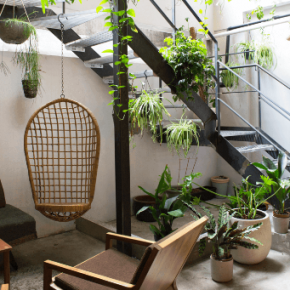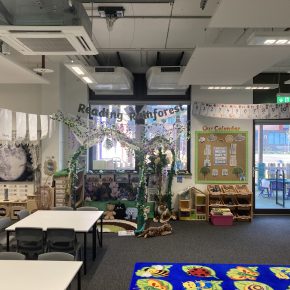
GUEST ARTICLE: The Future of Construction – how Sustainability will Shape Future Buildings
This article sees packaging retailers Rajapack speak about how new sustainable methods may go on to shape the buildings we design.
“We only have one earth – and every choice we make has a measurable impact on its being. Now more than ever before, society has the weight of the world on its shoulders, putting us all under pressure to change the way we live.
As each person pledges their own promises to the planet, industries are making moves as a collective to do their part, but what does this mean for the construction industry?
From the architects that design, to the builders and engineers that make their visions a reality, each sector should be prepared for the part a more eco-aware world could play within the industry.
Rajapack spoke to Kate Treggiden and Tiffany Grant-Riley about how new sustainable methods may go on to shape the buildings we design, construct or operate. Here we outline the main foresights, as well as what this could mean for the future of construction.
Green constructions
According to ENWORKS, the UK sends more household waste to landfill each year than any other EU country, which amounts to a staggering 18.8 million tonnes per year. Yet thinking sustainably should not only be limited to household items, but a full consciousness in the way houses are planned, built and utilised.
Enter: green constructions. These are buildings that, in their design, construction or operation, succeed in either reducing, or ridding the negative impacts of production and creating a better future for our climate and natural environment.
The UK Green Building Council has a mission to work towards, which includes ‘mitigating and adapting to climate change, eliminating waste and maximising resource efficiency, embracing and restoring nature and promoting biodiversity, optimising the health and wellbeing of people, and creating long-term value for society and improving the quality of life.’
Design writer Kate says: ‘I think and hope the Council’s mission will become the norm for all new buildings and this will see a lot more eco-initiatives being incorporated into homes and offices.’
Material innovation
One of the ways we are already seeing this is through the use of sustainable materials. A lot of material innovation is currently driven by sustainability and is set to continue in this way.
Kate gives some examples thus far, such as fast-growing and compostable fungal mycelium, for its use in cladding, structures and insulation. Another she suggests is Green & Blue’s bee bricks, which provide homes for bees that are in decline.
While Kate talks here about structure, this will be the case for the intricacies within the home, too. For example, Green Building Solutions suggests that plastic piping is a modern pipe material because of its “cost-effective, efficient and more durable means” for plumbing, central vacuum systems and cold air inlets for fireplaces and gas heaters. Sectors are constantly looking for materials to meet more eco-friendly goals, and this will develop further in all fields.
Giving new life to familiar materials
Kate also talks about the familiar materials we see everyday being made more of. One that she talks of a lot is cardboard; it is currently used for our food packaging, our stationery, our storage among others, but what about for a house?
Kate states that architects are attracted to cardboard’s ‘low cost, flexibility, strength, sustainability and recyclability.” It has already been used to trial emergency shelters, schoolhouses and concert halls. And most recently, a Dutch collective called Fiction Factor created cardboard ‘Wikkelhouses’ – made from 24 layers of corrugated cardboard, glued together and wrapped up in foil.
Integrated, multi-purpose spaces
In the interest of reducing waste, freelance interior stylist, writer and blogger Tiffany believes there will be a move towards more integrated, multi-purpose spaces.
She goes on to say that people will favour ‘precisely engineered modular furniture over single-use, large scale pieces.’
This means that smarter choices will be made with new materials chosen for their low environmental impact within the home, too.
She finishes by explaining that ‘consumer approaches towards sustainable design are changing’, meaning that the need for cheap, fast consumption products are being replaced by more tradiitonal craft that considers not just the now, but the future.
If it can be recycled, grown by nature or continuously used, there is a chance that it will be coming to a home installed by you.
As those that are a critical part of the design, construction and operation of properties, whether commercial or other, it is crucial to understand how these eco-friendly demands will continue to disrupt the industry.
Ultimately, those that can instill as little environmental harm as possible, and present efficient and resourceful solutions to future homes will be best-placed to outperform in their market.
Latest news

28th February 2025
Passivent ventilation solutions are top of the class
Passivent has supplied a combination of Hybrid Plus2 Aircool ventilators and Hybrid Plus Airstract roof ventilation terminals for a new London primary school.
Posted in Air Conditioning, Articles, Building Industry News, Building Products & Structures, Building Services, Case Studies, Ceilings, Facility Management & Building Services, Heating, Ventilation and Air Conditioning - HVAC, Restoration & Refurbishment, Retrofit & Renovation, Roofs, Sustainability & Energy Efficiency, Ventilation, Walls
28th February 2025
Troldtekt: New acoustic liner ensures good acoustics and easy handling
Both a building’s users and its developers have a good reason to get excited about the new Troldtekt Plus 25 panels. This specially developed acoustic panel sets a high standard for both sound absorption and building efficiency.
Posted in Acoustics, Noise & Vibration Control, Articles, Building Industry News, Building Products & Structures, Building Services, Building Systems, Ceilings, Facility Management & Building Services, Floors, Innovations & New Products, Insulation, Interior Design & Construction, Interiors, Restoration & Refurbishment, Retrofit & Renovation, Timber Buildings and Timber Products, Walls
28th February 2025
InstallerSHOW 2025 – Registration is now OPEN!
Building on the success of last year, InstallerSHOW is returning to the NEC from the 24th to the 26th of June…
Posted in Articles, Building Industry Events, Building Industry News, Building Products & Structures, Building Services, Exhibitions and Conferences, Health & Safety, Retrofit & Renovation, Seminars, Sustainability & Energy Efficiency
28th February 2025
ABLOY securing Helsinki’s heritage and Croatia’s waste management
ABLOY, part of ASSA ABLOY Group, has redefined its brand, focusing on the value it brings to customers around the world…
Posted in Access Control & Door Entry Systems, Architectural Ironmongery, Articles, Building Industry News, Building Products & Structures, Building Services, Case Studies, Doors, Facility Management & Building Services, Health & Safety, Retrofit & Renovation, Security and Fire Protection
 Sign up:
Sign up: